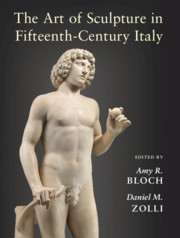Description
The Art of Sculpture in Fifteenth-Century Italy
Coordinators: Bloch Amy R., Zolli Daniel M.
Comprising nineteen essays by top scholars and a comprehensive introduction, this book surveys fifteenth-century Italian sculpture in all its variety.
Language: English
Publication date: 02-2020
454 p. · 22.2x28.7 cm · Hardback
454 p. · 22.2x28.7 cm · Hardback
Description
/li>Contents
/li>Biography
/li>
Fifteenth-century Italy witnessed sweeping innovations in the art of sculpture. Sculptors rediscovered new types of images from classical antiquity and invented new ones, devised novel ways to finish surfaces, and pushed the limits of their materials to new expressive extremes. The Art of Sculpture in Fifteenth-Century Italy surveys the sculptural production created by a range of artists throughout the peninsula. It offers a comprehensive overview of Italian sculpture during a century of intense creativity and development. Here, nineteen historians of Quattrocento Italian sculpture chart the many competing forces that led makers, patrons, and viewers to invest sculpture with such heightened importance in this time and place. Methodologically wide-ranging, the essays, specially commissioned for this volume, explore the vast range of techniques and media (stone, metal, wood, terracotta, and stucco) used to fashion works of sculpture. They also examine how viewers encountered those objects, discuss varying approaches to narrative, and ponder the increasing contemporary interest in the relationship between sculpture and history.
Introduction – making and unmaking sculpture in fifteenth-century Italy Amy R. Bloch and Daniel M. Zolli; Part I. Surface Effects: 1. The color white in fifteenth-century Tuscan sculpture Una Roman D'Elia; 2. The colors of monochrome sculpture Frank Fehrenbach; 3. New light on Luca della Robbia's glazes Catherine Kupiec; Part II. Sculptural Bodies: 4. Donatello, Alberti, and the free-standing statue in fifteenth-century Florence Peter Jonathan Bell; 5. Francesco di Valdambrino's wood sculpture at the high altar of Siena Cathedral Ashley Elston; 6. Sculptural transformations in Quattrocento Italy Megan Holmes; Part III. Sculptural Norms, Made and Unmade: 7. The body, space, and narrative in Central and Northern Italian sculpture David J. Drogin; 8. Rethinking style in fifteenth-century Italian sculpture Robert Glass; 9. Bellano's invention at the Santo Sarah Blake McHam; Part IV. Sculpture as Performance: 10. Sculpture and sacrifice Adrian Randolph; 11. Illuminated sculpture and visionary experience at the Cardinal of Portugal Chapel in Florence Morgan Ng; 12. Tullio Lombardo, Antonio Rizzo, and sculptural audacity in Renaissance Venice Lorenzo G. Buonanno; Part V. Sculpture in the Expanded Field: 13. Stucco as substrate and surface in Quattrocento Florence (and Beyond) Yvonne Elet; 14. The punch marks on Ghiberti's Gates of Paradise: an intersection of economy and ritual Lauren Jacobi; 15. Relief effects in Donatello and Mantegna Henrike Lange; 16. Candelabra-columns and the Lombard architecture of sculptural assemblage Michael J. Waters; Part VI. Sculpture and history: 17. Jacopo della Quercia's Fonte Gaia Amy R. Bloch; 18. Virgil's forge Daniel M. Zolli; 19. Quattrocento perspectives on the historical value of sculpture Joost Keizer.
Amy R. Bloch is associate professor of art history at the State University of New York, Albany and author of Lorenzo Ghiberti's Gates of Paradise: Humanism, History, and Artistic Philosophy in the Italian Renaissance (Cambridge, 2016). Her work has been supported by fellowships and grants from the Villa I Tatti (the Harvard University Center for Italian Renaissance Studies), the Renaissance Society of America, and the College Art Association.
Daniel M. Zolli is a scholar of early modern art and an assistant professor at The Pennsylvania State University. In 2015, he co-curated Sculpture in the Age of Donatello at the Museum of Biblical Art for which the accompanying catalogue was a finalist for the Alfred H. Barr Award of the College Art Association.
Daniel M. Zolli is a scholar of early modern art and an assistant professor at The Pennsylvania State University. In 2015, he co-curated Sculpture in the Age of Donatello at the Museum of Biblical Art for which the accompanying catalogue was a finalist for the Alfred H. Barr Award of the College Art Association.
© 2024 LAVOISIER S.A.S.





